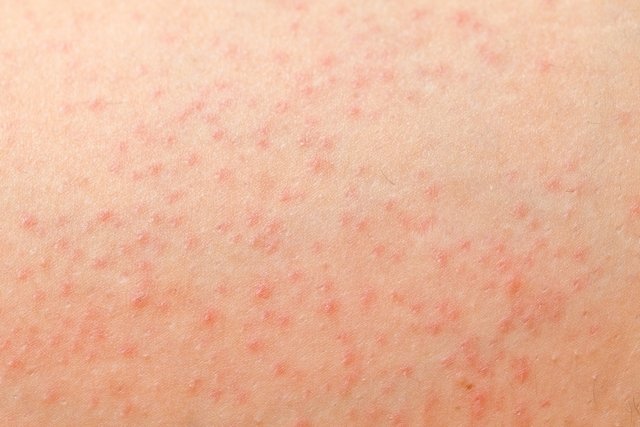Petechiae are red, pinpoint dots on the skin that generally appear in clusters as a result of bleeding below the skin or mucosa. They can also be purple or brown in color, and are commonly seen in the arms, legs, stomach, on the palate or eyes.
Petechiae can be caused by trauma, infectious diseases, abnormal blood vessels, allergic reactions, auto-immune diseases or medication side effects.
It is important to see your doctor or a hematologist if you frequently notice petechiae so that you can understand what is causing them and start treatment as necessary.

Possible causes
Petechiae are a result of microbleeding under the skin, which occurs due to an increase of pressure in local capillaries, decreased platelets for clotting, or platelet dysfunction.
Some conditions that may lead to petechiae are:
- Viral infections, like cytomegalovirus, hantavirus, infectious mononucleosis, dengue, ebola or yellow fever
- Bacterial infections,like strep throat, Rocky Mountain spotted fever, scarlet fever, or endocarditis
- Vasculitis, which is characterized by an inflammation of blood vessels due to a block in blood flow in the affected vessel. It can cause necrosis in the area of inflammation due to decreased oxygen reaching surrounding tissues
- Decreased platelet count, also known as thrombocytopenia
- Allergic reactions
- Auto-immune diseases
- Scabies, which is an illness caused by a low vitamin C level
- Sepsis, which is a systemic body infection
- Use of certain medications, like some antibiotics, antidepressants, sedatives, anticoagulants, anticonvulsants and NSAIDs.
- Leukemia, which is a type of cancer that affects bone marrow
In addition to these causes, skin wounds from accidents, direct blows, friction, animal bites, sunburns or insect bites can all cause these red pinpoint dots on the skin.
Main symptoms
The main symptom of petechiae is the formation of small pinpoint dots under the skin or mucosa. They are usually 1 to 2 mm in diameter and appear in clusters with a red, purple or brown color.
Petechiae are most commonly seen in the arms, legs or stomach, but can also appear in the mouth, on your back, or in the eyes, within your eyelids.
Generally these pinpoint red dots are accompanied by other symptoms that are characteristic of the condition that caused tehm, like a fever, headache, muscular pain, nausea or nosebleed.
Treatment options
Treatment of petechiae should be monitored by a family doctor hematologist, and will vary depending on the underlying cause. If the petechiae is a side effect of a medication, the doctor will consider discontinuing it and using an alternative medication.
Petechiae caused by bacterial infections can be treated with antibiotics, analgesics and anti-inflammatories to relieve other symptoms like pain, fever or inflammation.
When petechiae is related to a dengue infection, the doctor will recommend rest, increased fluid intake and analgesics like acetaminophen. Dengue can also be treated with a dengue diet.
Depending on the cause, the doctor may also prescribe corticosteroid or immunosuppressants.
When to worry
Petechiae is usually a result of bleeding into the skin, which can be provoked by a number of conditions. A child or adult who presents with a petechial rash and a fever should be urgently assessed by a doctor. Petechiae should also be assessed if this rash presents with any of the following signs or symptoms:
- Vomiting, nausea or diarrhea
- Recent contact with another person with a respiratory or gastrointestinal infection
- Other signs of bleeding (in the gums, stool, or other bruising)
- Decreased alertness
- Rapid heart rate or breathing
Petechiae rashes that spread rapidly are also a sign of concern. Parents and health care professionals are advised to demarcate the rash with a pen directly on the skin to monitor whether the rash remains confined to one area or if it does spread to other areas of the body.
